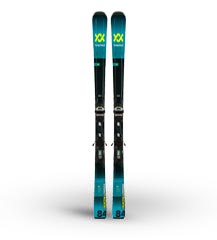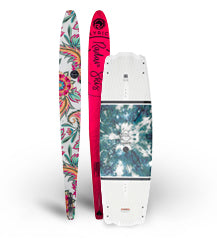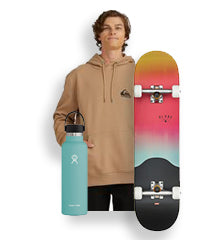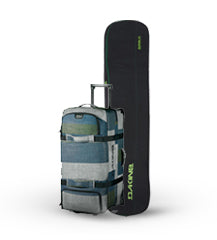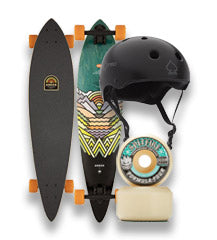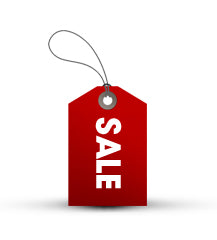Choosing Snowboard Length: What Snowboard Size is Right for Me?
April 03, 2024 17 min read
Choosing Snowboard Length: What Snowboard Size is Right for Me?
Snowboard length was once thought to be easy to determine as the distance from the ground to your chin; yet this was merely by coincidence in some cases. Selecting the proper snowboard size can be challenging. On how long or how short a snowboard should be, opinions frequently differ. Auski has developed a straightforward method for determining the ideal board size. First off, try not to get overwhelmed by all the technical jargon regarding cambers and flex ratings; there is a tonne of information available. Instead, focus on the following four factors: weight, height, ability, and where you spend the most of your riding time.
For each snowboard in our online store, the majority of manufacturers list the ideal rider weight, and all our snowboards online have size guides to assist you find the right size for you. The range is basically just a guideline, so it's okay if you end up outside of it. Personal preference also plays a role; if you fall out of the range, the board can feel a little stiffer, and if you go beyond the range, you might discover it rides a little softer.
There are four main elements that affect choosing the length of a snowboard, including: weight, riding style, ability level, and height.
Snowboard Weight
A snowboard rider's weight, which is unquestionably more significant than their height, is the main variable in deciding the length of the ideal snowboard. If you've previously rented and this is your first board, you're probably used to the rental shop sizing you up and placing you on any board that roughly falls between your chin and your nose. This is acceptable for riders of average height, but it ignores your weight, which is the most crucial criterion when picking the right size snowboard.
Your weight controls the snowboard when you are riding it; it dictates how the board will flex. Because of this, we usually advise choosing a board based on weight and height rather than just its height. You can ride to your full potential and worry less about losing control if your board works with your body weight.
A board that is too short for a bigger rider usually becomes loose and difficult to control at greater speeds. Over-flexing and potential wipeouts can also come from a board that is excessively soft and short; and this goes both ways. A lighter rider with an excessively lengthy snowboard will struggle to flex and handle the board. In certain circumstances, depending on your riding style, it is appropriate to scale down your board for a lighter setup and increased mobility to aid in pulling off those heavy-duty feats. For a more skate-inspired look and feel, freestyle riders who spend the most of their time in parks frequently utilise smaller boards. Scaling your board up a little may also be acceptable if you're on the heavier side, want to ride only powder, or want to do both. You may move faster across the powder by using a slightly longer board to maintain that nose above the snow line. A longer board will also have a stiffer response, which will increase stability.
Why is weight the most crucial element when choosing snowboard length?
Snowboards are made with a specific amount of flex in mind. However, the rider's weight also has an impact on that flex. The flex will not act as it was intended to and as you were told it should when you purchased the board if you are too heavy or too light relative to the weight the board was built for. The board will flex more than it should if you are too heavy for it (i.e., the board is too short for your weight). You won't be exerting enough pressure to cause the board to flex as it should if you are too light for the board (i.e., the board is too long for your weight). So make an effort to stay inside the board's recommended weight range. Then, you can consider further considerations. Many snowboard manufacturers will disclose the recommended weight for each size of a certain board – and these are listed with our size guides online for each board. Fitting within that range is an excellent place to start. Since the range is typically rather wide, we need some more variables to help us determine the length more precisely.
SNOWBOARD Ability Level
The length of an ideal snowboard may also be influenced by the rider's skill level. But this is really simple. In general, use a shorter board if you are a novice (3-5cm shorter). Ability level should not be taken into consideration when calculating length for anyone intermediate and up. Controlling a longer board is more challenging. Therefore, it is frequently advised for novices to select a somewhat shorter board than what a more experienced rider might do.
Beginner
You are usually a beginner if you are still learning how to connect turns. Snowboards for beginners should adhere to the usual weight, length, and width specifications, but you may want to consider some softer boards that are on the smaller side of your size range. By flexing more easily, a softer board can help beginners get down the hill faster. You can control the board more effectively and with less effort thanks to the shorter length. Stronger boards call for a little more effort and muscle, and learning to ride is already difficult enough.
Finding the right balance between flex and stability is important since using a board that is too soft can actually make you less skilled. Regarding length, a board at the shorter end of your size range will make manoeuvring it simpler and may also make it easier for you to link those turns smoothly. By significantly slowing you down, scaling down your board will give you more control. It merely allows you a little bit more time to restore composure before taking a horrible crash into the woods, so it won't necessarily impair your ability to keep up with your pals. Keep in mind that you should still get a board that fits your size and weight. Check out the technical details for each board because they differ from manufacturer to manufacturer, model to model, and year to year. And don't forget to take into account your particular preferences, which are crucial for creating your own shred style.
Intermediate
You've boarded for a few seasons and are eager for more.. As an intermediate rider, you may now focus on developing your talents in the direction of the riding style you choose. Look into a board that is made specifically for the riding style you prefer or would like to get better at while attempting to keep within your snowboard size and weight ranges.
Your best bet is to go with an All-Mountain style board in the middle of your snowboard size range if you prefer to do it all and want to keep that adaptability under your feet. A Freestyle board at the lower end of your board size range is typical equipment for almost all park riders if you want to start spending more time lapping the park and dialing-in hits on those boxes.
Do you truly enjoy going for the pow on the mountain's backside? The longer end of your size range freeride board is a good option and will hold up well in the deep snow. Check out the board type part of this reference guide for more information if you're interested in learning more about these and other accessible board kinds.
Advanced
You are familiar with all aspects of dominating the hill. You have years of riding experience, a bag full of tricks, and a favourite riding style. It's time to start paying attention to the specifics in your riding and setup now that you have the hard-earned experience to choose gear that suits you.
By this point, you are aware of the kind of board you require and the ideal size for it, but do you actually consider the technical details to see how they might enhance your total performance?
If not, you ought to. Your current focus should be on honing your already advanced talents so you can enjoy yourself to the fullest. Start examining items like fibreglass, carbon/kevlar, sidecut, and profile shapes in bars. Most new riders don't care about these subjects; all they want is a board with cool graphics and a well-known brand. True shredders go a little farther and pay attention to the little things. Refer to the relevant area of this article for more information if you'd want to know more about these snowboard construction specifics. To create the ideal board for your session, try out various combinations and attend demo days when the season opens to test out the latest boards and gear.
SNOWBOARD Riding Style
The rider's style might affect the length of snowboard that he or she chooses in addition to affecting elements like board flex, stance setback, etc. This is also very simple, though: if you just plan to go freeriding, go 2-4 cm longer (again, this will vary on preference, and some riders like to go more or less extreme than this), and if you ride freestyle, go between 3 and 6 cm shorter (depending on preference). For a freestyle board, subtract 3-6 cm, and for a freeride board, add 2-4 cm.
Important factors in the snowboard sizing formula are riding style and snowboard type.
The kind of terrain you choose to ride on is referred to as riding style. Some riders prefer to ride everything, while others choose to concentrate solely on snow or only in parks. Terrain-specific boards are available to accommodate the various riding styles. Your riding style and the kind of board you use are intimately related. An edgeless street deck is generally not what someone who rides powder should use; instead, they should choose a deck designed for powder. Knowing the differences between the various types of boards is a good idea because of this.
Each of the categories is outlined below to assist you in determining what kind of riding style you mainly enjoy and what kind of board you require. Just keep in mind that these suggestions are only a starting point and that boards can also be a combination of board types, such as all-mountain-freestyle models for a versatile ride with the liveliness of a park board, etc. You'll be one step closer to discovering the ideal snowboard to satisfy your individual needs if you identify the riding style and board type that work best for you.
All-Mountain
All-mountain riding is the most popular snowboarding type. The majority of snowboarders are adaptable winter creatures that make use of everything the mountain has to offer. You might just be an all-mountain maniac if you choose to run a few laps in the park before making your way into some wooded routes. This is undoubtedly your category if you're a keen explorer of anything to shred. All-mountain boards are designed to handle anything you can throw at them. Take off park jumps, enjoy yourself in the pipe, blaze groomers, or even get buried in a recent snowfall. In all of these, All-mountain snowboards work flawlessly. The board shapes and camber profiles of snowboards that belong to the all-mountain board category might vary. Choose your preferred combo, then start riding. For beginners, this board type is a wonderful place to start. You can ride anything you wish thanks to the all-mountain adaptability until you discover the style of riding you enjoy the best.
Freestyle
Your riding style falls under the freestyle category for the trick makers, risk takers and park rats. Your riding is undoubtedly freestyle if you spend more time on tow ropes and handrails than on the chairlift. Although freestyle snowboarders are capable of doing it all, their major goal is to advance in the park, pipe, and street, and they accomplish this with a board that is geared towards freestyle.
Freestyle snowboards often have a little less flex and are sized slightly smaller than standard snowboards. When executing tricks, you may throw the board around more easily due to its smaller size. Additionally, a gentler flex will enable you to adjust those tricks for the right swagger and flair. To resist the everyday abuse they receive from the parks, these boards are frequently constructed with a strong foundation and some harsh edges. True twin-shaped freestyle boards are available in a variety of camber types, including flat, classic, rocker, and combinations of these. Because of the board's light weight and forgiving flex, this is another style of board that novices frequently use. Beginners may learn to control the board and its edges more quickly and easily thanks to the smaller board.
Freeride
You probably identify as a freeriding enthusiast if you believe that snowboarding should only be done on snow, or that’s your usual playground on the mounatin. The genre of freeride riding includes everything from ripping groomers to slogging through a mountain of pow in the backcountry. Riders who have access to real mountains to ride or who live in areas with plentiful snowfall frequently use this riding technique. At its core, freeriding is snowboarding and will always be a significant component of the sport. On the backside of that mountain, there is an entirely different world. A board designed specifically for freeride is what you'll need to get the job done. The lengthier end of your board size range is frequently used for freeride board varieties. Those few extra centimetres are crucial for staying on snowy pillows. Freeride boards can have a directional twin shape but are often directional shaped boards. For improved reaction and stability when bombing at high speeds and cutting deep, these boards also have a stiffer flex.
Splitboarding
Splitboarding may be your prefered riding style if you're a true shredder who likes to hike your own routes. The conflict between snowboarding and skiing is over. It's time to maximise the use of both sets of tools and to have a great time. Splitboards are an alternative for riders who are unwilling to wait in line at the ticket booth or gondola. These folks trek up every inch of what they descend in order to obtain their turns. Anyone who says ski and board bums are lazy has never heard of split-boarding. A splitboard is the ideal type of board for competitive freeriding. A board made of two independent pieces that split to form a pair of skis is the stuff of backcountry riders' dreams. Reattach the skis so you may snowboard back down the slopes after using them to cross some previously discovered terrain. It is the best design for people who have the bravery to tackle untracked slopes.
Where You Ride – Snowboarding Location
Where you snowboard is significant because some riding techniques call for longer or shorter boards. It is beneficial to scale down significantly if you spend more time in the park in order to perform quicker turns, faster spins, and to have greater control while buttering through boxes and rails. You might want a little longer board if you enjoy exploring the backcountry and searching for powder. You'll be able to float above the snow thanks to the larger surface area of a longer board, just like a surfboard does in water. As opposed to what we may suggest to someone visiting abroad, we often suggest a somewhat smaller board for the typical Australian rider.
SNOWBOARD Height
A snowboarders height is still something of an influence even if it is undoubtedly not as significant as weight, in part because a taller rider would weigh more than a shorter rider (with the same build); moreover due to the fact that taller riders often have wider stances (though not always).
When a tall rider is on a board that is too short for their stance width, they may not be able to set it as wide as they would want or they may be at the widest stance possible, which may not be the greatest position for them on the board. A shorter rider may find it difficult to ride as narrowly as they would want on a longer board, or they may feel as though there is too much board sticking out past the inserts.
When deciding on a snowboard length, height is likely the first measurement that comes to mind, but it may not always be the most accurate. Nevertheless, consumers have always and most likely will always size snowboards solely based on height. Over the years, a number of techniques for sizing snowboards by height have emerged. According to the conventional way, when the board is held on end, a shorter board for your size range should fall between your collar bone and your chin. These shorter boards are suitable for freestyle and novice riders. If the board were longer, it may extend from your nose to just above your head. The larger length boards are better for high speed and powder. Although they are not as precise as some of the other approaches available, these are nevertheless good general rules of thumb that many riders like to use when making board-buying decisions.
Snowboard sizing calculators are popular among certain snowboarders. By entering a few figures into a straightforward calculation, you may determine the board length that could work best for you as most snowboarders ride a board that is between 85 and 92 percent of their own body height.
The equation reads as follows:
Your Recommended Board Length is equal to Your Height (in Inches) X 2.54 X 0.88. Despite the fact that this formula incorporates numbers, arithmetic, and a little bit of homework, it doesn't imply you have to accept the end number. It is primarily intended to be used as a jumping off point for choosing a new board.
Height is a crucial element, but also take into account your weight, riding style, and the technical specifications provided by the manufacturer for each board.
Choosing Snowboard Length: Length & Size Charts
Based on height and weight, the charts below provide estimations regarding board length. Once you've found your length, you've discovered what we'll refer to as the "standard length." Using this, you should modify the length based on your preferred riding style (and ability level if you are a beginner). Depending on style and skill, this could be the same as the usual length or different.
Browse the charts below, choose the one that corresponds to your height, and then scroll until you find your weight. Then you can make adjustments e.g. if you don't consider yourself a novice, but do incline towards freestyle riding, subtract 2 to 6 cm, which gives a "length range" of 154 to 158 cm. You could choose the higher end of the spectrum there, 157cm, for an all-mountain-freestyle rider who does a little bit of everything rather than just pure freestyle. Therefore, with the actual length being 157 cm, you can now give any board that is 156–158 cm serious consideration because a difference of 1 centimetre won't be visible but will increase the variety of boards you may pick from. Additionally, it depends on the board. Depending on certain board-specific characteristics, 159 could be better in one board while 155 might be better in another.
Remember that this is only a general recommendation; if you can locate the recommended weight range for the specific board you are interested in, that information is also helpful, so refer to each of the sizing guides for snowboards online at Auski. The chart above should help you identify a size that falls inside that range.
Youth & Kids Snowboard Sizes
It's just as simple to size a snowboard for kids as it is for adults. The kid's and youth model boards are subject to the same weight and height restrictions. When selecting a new board for kids, these recommendations should still be taken into account. Purchasing an adult-sized board that they believe their child can grow into is a typical error made by parents. This will only make it more difficult for your child to pick up the sport of snowboarding and advance. Kids will find it more difficult to turn and manage a longer board. Make sure it fits properly when you purchase one.
The rider has a little bit more control since youth boards are often softer than adult boards. To fall in love with the sport, remain with it, and eventually rule the slopes, novices must have all they require. Again, all kids snowboards have a sizing guide online.
Common Questions & FAQs when Choosing Snowboard Length
What size snowboard do I need?
Without a doubt, this is the query that is asked the most in stores. Although there isn't a single best solution, choosing your configuration is easy after you understand a few basic concepts regarding snowboard size. It also helps visiting an Auski store in-person, as one of our snowboard specialists can take all the measurements, then discuss all snowboards that fit your ability and riding style.
When selecting a new board, it is crucial to take into account your weight, height, and riding style. It is also advised that you review the technical details provided by the manufacturer for each board. Don't overlook your individual preferences however, which are an essential component of the ideal snowboard.
What is the difference between beginner and advanced snowboards?
The answer is probably “there’s a slight difference” as beginners should utilise a board that is a little softer and shorter in length to advance more quickly. Advanced freeride snowboarders may utilise longer, stiffer boards that require more strength and finesse to control. However, the answer can be “there is no difference” because some experienced freestyle riders utilise smaller, softer boards to help them complete tricks. Although a board may appear to be a beginner-style board, elite freestyle riders utilise them for entirely different purposes. In conclusion, everybody is free to use whichever board they like. Finding the right fit for you and your riding style is all that's required.
How do I know if I’m regular or goofy?
Riders that ride with their left foot forwards are said to be in a normal stance. Goofy snowboarders put their right foot ahead while they ride. You may use a few different techniques to establish your stance. Running and sliding on a flat surface in your socks while determining which foot you put front is a pretty frequent and kind of amusing way to determine your favourite stance. On a snowboard, your lead leg will most likely be the foot that is placed forwards. Having someone gently push you backwards from their chest and seeing which foot you naturally place behind you for support might be another way to tell if you're normal or goofy. In this situation, your rear leg could function best with the foot you position behind yourself.
How wide should my snowboarding stance be?
Due to the fact that each person is unique, there is no single right response to how wide a stance should be. Your stance should, in general, be as broad as or somewhat wider than your shoulder width. If you enjoy the park and riding huge kickers, widening your stance may be beneficial when attempting to keep control in the air and when stomping challenging landings. Too narrow of a stance is a typical error. Your ability to balance will be compromised if your stance width is smaller than your shoulder width. A stance that is too tight might make it more difficult to turn and control your board. Find a comfortable width and keep it straightforward. On the ground, place your board flat, then stand on it. Your stance should be adjusted by extending your feet out until you feel secure and are balanced over the board. Put those bindings on now and test it out; tweaks are always possible.
How often should I tune my snowboard?
Whether you are a first-time rider or a seasoned shredder, board tuning is crucial to maintaining the condition of your snowboard. Regular tuning of a snowboard improves edging skills and also helps the board operate at its best. In order to avoid potential snags like cuts and burs, freestyle riders frequently detune or dull their edges. As a general rule, a snowboard has to be adjusted by a pro at a shop at least once each year. Did you know Auski has a fully serviced Snowboard Workshop with tuning? Most services typically take 48 hours to complete; during periods of high demand, please allow up to 5 days. Services include waxing, wax and edge, minor service, major service, binding mounts and repairs.
How often should I wax my snowboard?
Regular snowboard waxing will provide the best performance on the slopes. Your board will glide better with a fresh layer of wax, making it quicker and more responsive. Anytime the base of your board begins to look worn or dry, waxing should be done. It's time for a wax if you see any faint white lines or patches, especially close to the borders of your board. Wax comes in a variety of varieties, each with unique properties. There are waxes designed for warm and cold climates, respectively. Additionally, all-temperature wax is available to handle a variety of situations.
Although board waxes are typically reasonably priced in stores, you may also wax your board yourself. View all our snowboard wax and tuning materials online.
I Know My Snowboard Length, What Next?
It's time to learn more about some additional factors to get you on the ideal board now that you've presumably determined your length range. To pick a board that will suit your riding style and preferred locations, browse our snowboards online, using the size guides to find a decent snowboard in your length range.
Read more on How to Choose a Snowboard and How to Choose Snowboard Boots.
If you have any questions, please feel free to comment below or get in touch with us and a snowboard specialist can help with any specific questions you may have.
Leave a comment
Comments will be approved before showing up.
Also in Blogs

How to Kneeboard for Beginners: Tips, Tricks, and Safety Advice
August 21, 2025 11 min read

The Ultimate Guide to Snowboarding at Rusutsu Resort, Hokkaido
July 15, 2025 13 min read

10 Wakeboarding Accessories Every Rider Needs in 2026
June 16, 2025 9 min read



